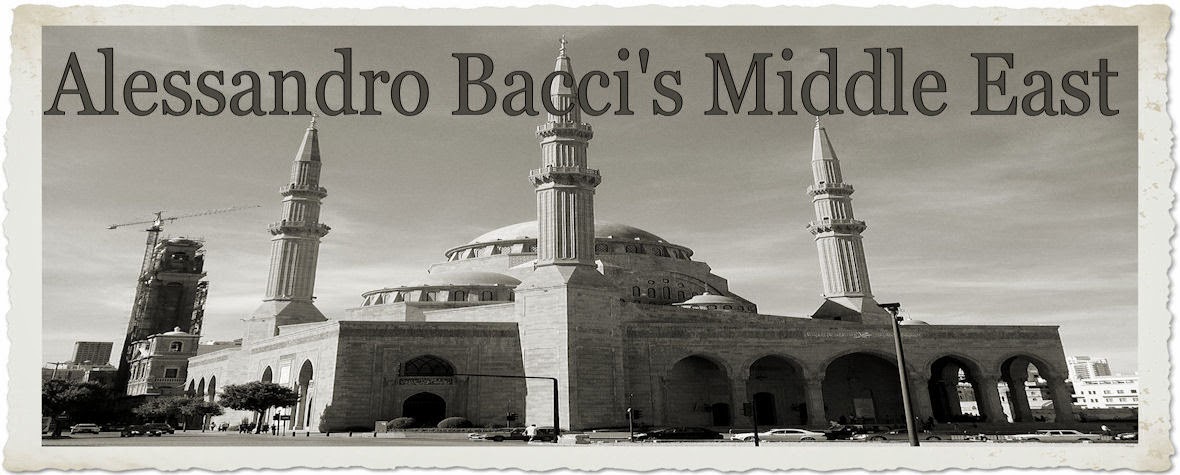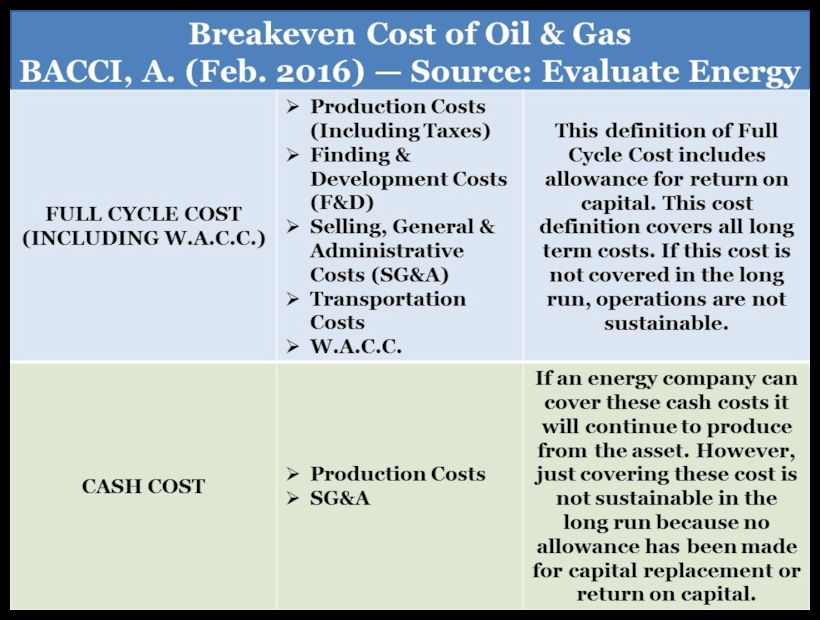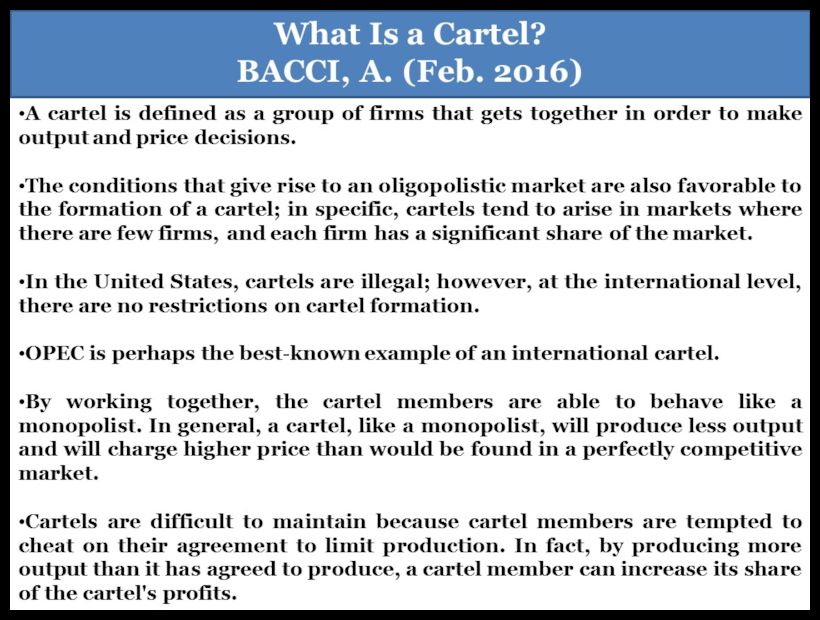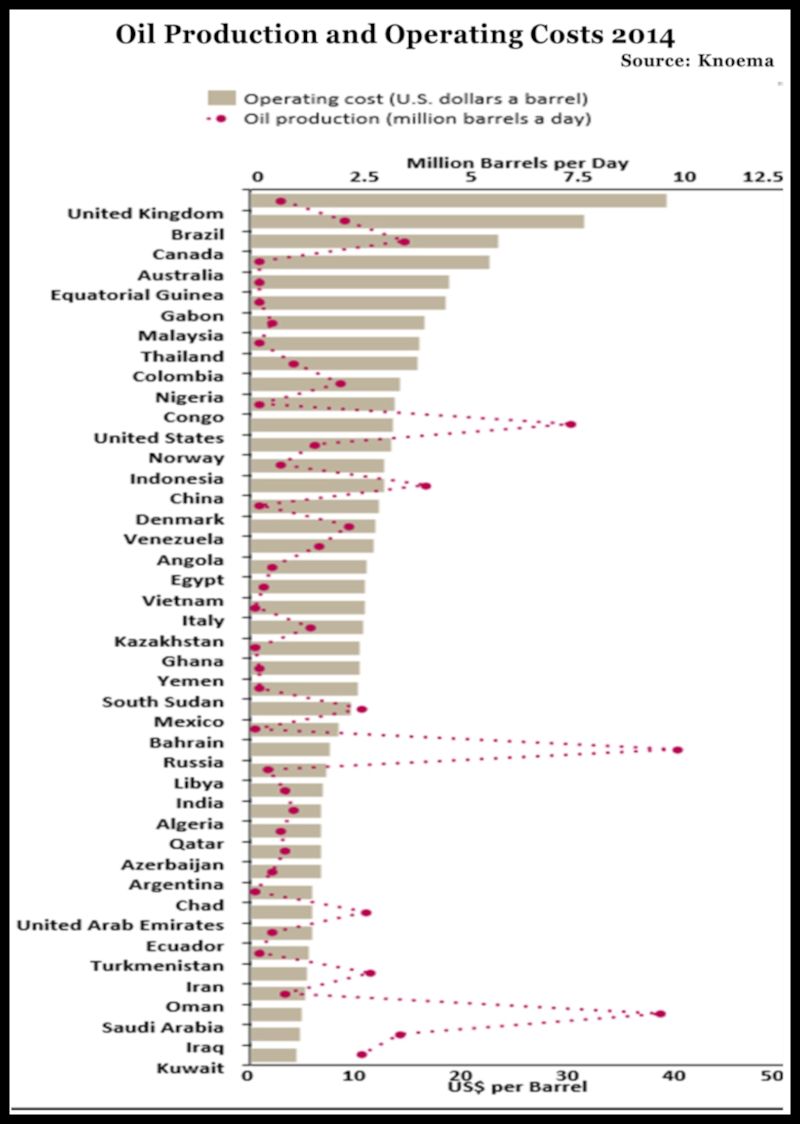The analysis “A Crude Oil Glut, Low Oil Prices and the Problematic Fiscal Budgets of Many Oil-Producing Countries“ has been initially
published by Oilpro, a professional network for
the oil and gas professionals.
February 3, 2016
HOUSTON, Texas — W.T.I and Brent are telling us a
narrative of low prices. W.T.I is valued $29.70 a barrel and Brent $32.53. With
no doubt it a sea change from the values of June 2014 when oil prices stood at more
than $110 a barrel. Apart from a certain dose of structural short-term irrationality
of the commodity markets (sentiment), it is a fait accompli that crude oil producers are extracting more oil than
the oil really purchased on a daily basis. Today, there are approximately two million and
a half of crude oil barrels in excess; production hovers around 96.3 million
barrels per day (bbl/d), while demand is 94.5 million bbl/d. These barrels in
excess, which amount to 1.8 million bbl/d, are stored in tanks and tankers (the
U.S. is currently on an expansion spree with reference to its storage units for
crude oil); in practice who owns these barrels is waiting for better times in
order to sell them — some inventories have grown driven by the expectation of
higher prices in the coming months (the contango effect, i.e., high inventories
lead to a discount in the spot price relative to the forward price, generating
an upward slope in the forward curve). For the time being, places where to
store these unsold barrels are still available, but of course these exceeding
quantities are at least partially slowly filling them up at least in the U.S. According
to the Energy Information Administration (E.I.A.) the U.S. has a total capacity
for oil products (not only crude oil) of a little more than 1,500 million
barrels and a maximum crude oil capacity of 551 million barrels. Current crude
oil inventories are around 500 million barrels. Real numbers concerning storage
capacity are not easily available at the world level because outside of the
O.E.C.D. countries there are really scarce data.
It’s evident that there is a glut of crude oil. In
fact, one of the primary reasons for this 70 percent reduction in the crude oil
prices in just eighteen months is the increase in the number of barrels
produced in the U.S. over the last years. Shale oil has become a reality, and
America has been able to increase its production by 4.2 million bbl/d over the
last five years (these added barrels are equivalent to 4.3 percent of the
overall present crude oil production at the world level) — it’s indeed a very significant
increase. On top of this, slow growth in the global economy has compounded the
reduction in the price of oil. In this regard, some analysts have put the blame
on China’s economy, which has partially slowed down, but a detailed analysis
show that, notwithstanding a reduced economic pace, China is still buying its
average quantities of crude oil, at least until now. In general, low oil prices
should stimulate global economic growth because both oil-utilizing industries
and normal citizens save more money, but this time this phenomenon, i.e., the
benefits to oil-consuming nations, which typically outweigh the costs to
producing ones, are not occurring.
THE
SAUDI STRATEGY
Recognizing the changed market conditions, in
November 2014 during an OPEC meeting, Saudi Arabia forced the other member
states not to cut their oil production but to continue to produce at full
speed. The reason was quite simple: Because most of the OPEC members — and
among them the Persian Gulf producers — have very low productions costs, while
shale oil producers have higher production costs (although some recent
improvements have in general reduced the production costs of the U.S.
unconventional oil), Saudi Arabia wants to maintain OPEC’s market quota and to push
toward bankruptcy many American producers. In the 1980s, when OPEC decided to
cut production in order to sustain crude oil prices, initially it ended up
losing a relevant market quota in favor of the North Sea producers; only after
five years, in 1985, Saudi Arabia inverted its position flooding the market
with cheap oil — as a consequence oil prices went as low as $10 per barrel.
Within OPEC the present Saudi strategy is well supported by Kuwait and the
United Arab Emirates, but some other member countries are not convinced because
they desperately need money in order to run their daily government operations; outside
of OPEC also Russia would like to implement some production cuts, although for
Russia, in light of its ageing fields and limited production technology, it’s
easier said than done. Within OPEC, only Indonesia has a mixed economy; all the
other member states are strongly dependent on the revenues they get from
selling crude oil, so that when the price of oil is low, they consequently earn
fewer dollars.
Over the last years Saudi Arabia, Kuwait, Qatar
and the U.A.E. have been able to put aside relevant financial resources so that
they are able now to endure a period of low oil prices — although this
translates immediately in an increased financial deficit. For instance, Saudi
Arabia after the price reduction of the last months has still $630 billion in
financial reserves, but every month Riyadh now spends between $5 billion and $6
billion of these reserves — Saudi Arabia’s foreign reserves fell by $100
billion last year and a double-digit budget deficit is expected this year as
well. It’s clearly evident that Saudi Arabia’s financial position is not as
good as it was in June 2014, but Riyadh has plenty of room to maneuver, which
means that it could continue along this path of low oil prices for several
months. A similar consideration could be done for Kuwait, Qatar and the U.A.E.
In other words, all these countries, at least in the short term, are able to
maintain their social contracts (the generous allowances to which their
citizens are entitled).
A much more complex picture emerges from an
analysis of the economic conditions of countries such as Iraq (and the semi-autonomous
Kurdistan Regional Government, the K.R.G.) and Venezuela, within OPEC, and
Russia outside of OPEC. These countries desperately need to have higher oil
prices for fear of an economic collapse. Let’s consider Iraq proper and the
K.R.G., which, in addition to facing already difficult economic conditions, are
waging a war on the Islamic State. Iraq’s federal budget for 2016 forecasts a deficit of $20.1 billion (24.1 trillion dinars), but
there are two significant factors that could undercut the projected $68.1
billion in revenue. In fact, the budget envisages oil exports of 3.6 million bbl/d and an oil price of $45 per
barrel. In particular, current crude oil prices are quite far from the price
posted in the law. It’s also important to remember that Basra Light Crude sells
at a discount to W.T.I. (the benchmark for the U.S.), to Brent (the benchmark
for Europe) and to Dubai Crude (the benchmark for Asia). The K.R.G. has racked
up $18 billion in debt and experiences difficulties in paying governments
employees and security forces. At the same time, Iraq proper tries to avoid the
above mentioned possible budget shortfall. Last year it obtained a loan from
the World Bank, and it would like to obtain some other funds from the
International Monetary Fund (I.M.F.). Moreover, as a consequence of the decline
in the price of oil, Baghdad is seeking a renegotiation of its Technical
Service Agreements (T.S.C.s) with the international oil companies (I.O.C.s)
working in Iraq proper.
Because the world is awash with crude oil, oil
firms have put off investments in the order of $380 billion of new projects. And
if history is any indication, later these postponed investments will probably contribute
to an increase in the oil prices; in the oil business, with reference to
conventional oil, if you do not invest every year you normally have a 6 percent
natural decline in the production rate. And estimates tell us that the world
oil market will need another 7 million bbl/d of production by 2020. The U.S. is
slowly cutting production (from 9.6 million bbl/d to 9.2 million bbl/d); dozens
of small companies working with shale oil have gone bankrupt; oil producers
have dropped their rig count. But, as usual, the readjustment in the oil
industry takes time. In fact, if an energy company can cover PRODUCTION COSTS
and SG&A (selling, general and administrative expenses), it will
temporarily continue to produce from the asset because stopping operations with
all the involved sunk costs will cost more. Of course, this is only a temporary
procedure because a company needs to earn a profit on top of the capacity of
covering all the incurred expenses (including CAPEX and RETURN ON CAPITAL). In
the meanwhile, U.S. banks are putting aside reserve in order to absorb
additional losses linked to the impossibility of oil producers to repay their
loans, although it should be pointed out that, thanks to hedging mechanisms,
many energy companies are still receiving as much as $80 a barrel; the hedging
effect should conclude its trajectory over the first months of 2016.
WHERE
WILL THE NEW CYCLE BE ON A PRICE MAP?
In the long run oil prices are cyclical: The
upswing of the cycle is eventually followed by the downward slope and then
another cycle starts again. The real problem in the oil markets is not to
understand what the final future oil price will be (an impossible task), but
what type of prices will develop once the glut is over. The price of oil is the
combination of asymmetric and missing information; of the necessary investment
of conspicuous and often highly leveraged capital expenditures over a long
lead-time horizon; and of financial price discovery, i.e., the interactions
between buyers and sellers. Is this kind of combination ever able to result in
a permanent state of equilibrium? No. Balance occurs by accident and only for
short timeframes.
In other words, we have to take for granted that
oil is an inelastic commodity and that oil markets are cyclical and subject to
extreme volatility. Today, financialization rules; the traded physical oil is
probably 30 times smaller than the traded volumes of oil derivatives and
options. But, other question is trying to understand what the position of the
new cycle will be on the price chart, and what a possible, but temporary,
equilibrium price will be? In this regard, some preliminary considerations have
to be introduced. In fact, today, notwithstanding:
- a war in Libya (a producer),
- a war in Iraq proper and the K.R.G. (both producers),
- a crippled oil industry in Iran as a consequence of the international sanctions imposed on the country; the sanctions have been only recently lifted (a producer),
- a war in Syria (a relevant geopolitical actor in the Middle East) and
- an ageing oil industry in Russia (a producer),
there is an oil glut of almost 1.8 million bbl/d. And,
it’s sure that all of these countries are interested in re-entering the oil
markets or in expanding their oil production. Moreover, some “stable” countries
had already plans to expand their current oil production as well. For instance,
some years ago, Kuwait envisaged the necessity of bringing its oil production
to 4 million bbl/d by 2020 from the current production of 3 million bbl/d, and
despite the low oil prices, Kuwait is still committed to achieving this
target.
So, in light of these considerations, are we
entering an era of abundant oil? It’s difficult to say. What scares is that, if
they want to obtain the breakeven of their fiscal budgets, many of the
oil-producing countries need a level of oil prices completely misaligned with
what the prices of the new oil cycle could be — a cycle that could accommodate
more producers. When Saudi Aramco pays around $5 of OPEX to extract a barrel of
crude, but then Riyadh needs an oil price of $93 to balance its national fiscal
budget, there is something scary. And the same is true for all of the Middle
Eastern producers. The importance of OPEC, a cartel, lies exactly in
maintaining high prices while restricting competition. But, it is worth noting that
a cartel is able to control the shape of the forward curve, i.e., the cyclical
component of the price of oil but not the long-dated oil prices, i.e., the
structural factors. OPEC member countries produce about 40 percent of the
world’s crude oil and need high oil prices in order to compensate the almost
complete lack of diversification of their economies.
IS THE OPEC GAME STILL PLAYABLE IN THE FUTURE?
The answer will depend on several question marks.
One of the them is if the U.S. shale producers will be able to cut their
production costs. It’s difficult to fathom what the cost to the U.S. frackers is and will be. In fact, there are very different estimates. According to
WoodMackenzie, an energy consultancy, most shales are profitable to drill at
$50, but the same company has changed its estimates more than one time in the
last few months. Two years ago a shale well cost in the Bakken around $12
million, today it costs $6 million. These preliminary data (be it clear not
confirmed) seem to show that U.S. the shale oil will at least outcompete
deepwater oil, oil sands and Arctic oil. Second question mark: It is evident
that the “troubled” countries mentioned above if stabilized will increase their
production (only Syria has a negligible oil production), but how much will they
increase their production? Third question mark: Similarly, an increase could
come from the production of some “stable” countries that in the last years have
decided to expand their oil production, but how much will they increase their
production?
Moreover, cartels are prone to cheating. Right now
Saudi Arabia does not want to cut production because it knows very well that
some other OPEC members will agree on that on paper, but then they will act as
free-riders continuing to produce as many barrels as before. In practice,
Riyadh does not want to increase the world oil prices reducing its own revenues
but in practice subsidizing those of some other OPEC member countries. If
coordination is already difficult to reach within OPEC, much more difficult is
to find an agreement including OPEC members and non-OPEC oil-producing countries.
It is a very complex task. But, it’s evident that without cooperation among the
producers there will always be volatile highs and lows with the related
financial distress. We can call it a purely market-driven “screeching
rebalancing” instead of a cooperative game.
THE SCARY PROBLEM FOR MANY OIL-PRODUCING COUNTRIES: A REAL ECONOMIC COLLAPSE
What is currently happening out there, in the oil
markets, is an economic war between Saudi Arabia and some other sheikdoms of
the Persian Gulf on the one side, and the U.S. shale producers, but also Iran
(an OPEC member) and Russia, on the other side. Some of these players, such as
Saudi Arabia, have a lot of ammo, other don’t. A simple look at the following
two pictures, the first one showing the operating costs for crude oil
extraction and the second one the required crude oil price in order to balance the
fiscal budget, put well in evidence the risk of economic collapse that many oil-producing countries might face.
Many oil-producing countries have very low operating costs, but then they need very high crude oil prices in order to balance their budgets. In light of the considerations expressed above in the analysis, it is difficult to imagine oil prices to rebound soon to levels permitting many of these countries to balance their budgets. These are really frightening prospects because the economic sector of countries such as Iraq proper, the K.R.G., Bahrain, Libya, Russia, Nigeria and Venezuela is in completely dire conditions. Because in many parts of the MENA region the situation is already very challenging with 4 armed conflicts (Libya, Syria, Iraq and Yemen) going on, scarce economic resources will add to the present chaos destabilizing even more these fragile countries. And destabilization and poverty mean that fighting the Islamic State will be more difficult, that more people will try to move to other continents (primarily to Europe) and that there will be a wide area of instability on the world chessboard. This situation is in practice a time bomb.






